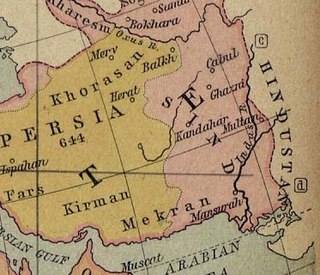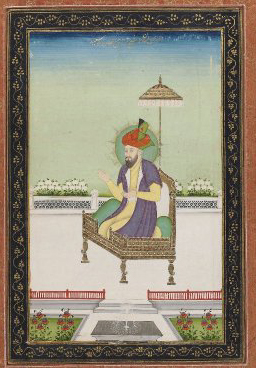
Babur was the founder of the Mughal Empire in the Indian subcontinent. He was a descendant of Timur and Genghis Khan through his father and mother respectively. He was also given the posthumous name of Firdaws Makani.

The Chagatai Khanate, or Chagatai Ulus was a Mongol and later Turkicized khanate that comprised the lands ruled by Chagatai Khan, second son of Genghis Khan, and his descendants and successors. At its height in the late 13th century the khanate extended from the Amu Darya south of the Aral Sea to the Altai Mountains in the border of modern-day Mongolia and China, roughly corresponding to the area once ruled by the Qara Khitai.

Muhammad Shaybani Khan was an Uzbek leader who consolidated various Uzbek tribes and laid the foundations for their ascendance in Transoxiana and the establishment of the Khanate of Bukhara. He was a Shaybanid or descendant of Shiban, the fifth son of Jochi, Genghis Khan's eldest son. He was the son of Shah-Budag, thus a grandson of the Uzbek conqueror Abu'l-Khayr Khan.
Ahmad Alaq was the Khan of Eastern Moghulistan from 1487 to 1504. He was the second son of Yunus Khan. His mother was Shah Begum, fourth daughter of Badakhshan prince Lali.
Qutlugh Nigar Khanum was the first wife and chief consort of Umar Shaikh Mirza II, the ruler of Ferghana Valley. She was a princess of Moghulistan by birth and was a daughter of Yunus Khan, the Great Khan of Moghulistan.

Esen Buqa II was Khan of Moghulistan from 1429 until his death. He was the younger son of Uwais Khan.

Yunus Khan, was Khan of Moghulistan from 1462 until his death in 1487. He is identified by many historians with Ḥājjī `Ali, of the contemporary Chinese records. He was the maternal grandfather of Babur, founder of the Mughal Empire.
Sultan Mahmud Khan, was Khan of Tashkent and of the Moghuls of western Moghulistan (1487–1508). He was the eldest son of Yunus Khan. He was born in 1464, his mother was Shah Begum, daughter of Badakhshan prince Lali, who claimed his descent from Alexander the Great and gave one of his six daughters to Yunus Khan in marriage, pleasing his request.

Moghulistan, also called the Moghul Khanate or the Eastern Chagatai Khanate, was a Mongol breakaway khanate of the Chagatai Khanate and a historical geographic area north of the Tengri Tagh mountain range, on the border of Central Asia and East Asia. That area today includes parts of Kazakhstan, Kyrgyzstan, and northwest Xinjiang, China. The khanate nominally ruled over the area from the mid-14th century until the late 17th century.
Sultan Said Khan ruled the Yarkent Khanate from September 1514 to July 1533. He was born in the late 15th century in Moghulistan, and he was a direct descendant of the first Moghul Khan, Tughlugh Timur, who had founded the state of Moghulistan in 1348 and ruled until 1363. The Moghuls were turkicized Mongols who had converted to Islam.

In 1504, Babur besieged Kabul and took the city from the Arghuns under Mukim Beg Arghun, to become the new king of Kabul and Ghazni regions. The territory gave him respite from his Uzbek troubles in Central Asia. It allowed him to build his nascent kingdom into a strong and formidable power in later years, enough to conquer northern India.

Umar Shaikh Mirza II was the ruler of the Fergana Valley. He was the fourth son of Abu Sa'id Mirza, the emperor of the Timurid Empire in what is now Kazakhstan, Uzbekistan, Afghanistan and eastern Iran.
Sultan Ahmed Mirza was the eldest son of Abu Sa'id Mirza on whose death he became the Timurid ruler of Samarkand and Bukhara from 1469 until 1494. During his rule, he successfully repelled at least one invasion attempt by the Kara Koyunlu, and failed in an attempt to conquer Khurasan from its ruler Sultan Husayn Mirza Bayqara. He was embroiled in the Timurid Civil Wars with his brothers Umar Shaikh Mirza II and Sultan Mahmud Mirza. He died while returning from his Ferghana expedition against Babur, the twelve-year-old son and successor of Umar Shaikh Mirza II. As he had no male heir, he was succeeded by his brother, Sultan Mahmud Mirza.

The Battle of the Chirciq River was fought between Sultan Mahmud Khan of Moghulistan and Sultan Ahmed Mirza, the Timurid ruler of Samarkand & Bukhara in 1488 CE over the city of Tashkent. The Moghuls decisively defeated the Timurids as a result of the defection of 3,000 Uzbeks under the command of Muhammad Shaybani Khan.

Khanzada Begum was a Timurid princess and the eldest daughter of Umar Shaikh Mirza II, the amir of Ferghana. She was also the elder sister of Babur, the founder of the Mughal Empire. She and her brother remained deeply attached to each other all their lives, a period during which the family progressed from ruling a tiny and obscure principality in Central Asia to ruling a large portion of the Indian subcontinent. Babur conferred on his sister, the honorable title of Padshah Begum and she was really the first lady of his Empire after his death.

Aisan Daulat Begum was the first wife and chief consort of Yunus Khan of Moghulistan. She was the mother of Qutlugh Nigar Khanum, and hence the grandmother of the first Mughal emperor, Babur. During the reign of her grandson, she functioned as his de facto regent and advisor, from 1494 to 1505.
Shah Begum was the Queen consort of Moghulistan as the second wife of Yunus Khan, a descendant of Chaghatai Khan, the second son of Genghis Khan. She was the mother of Mahmud Khan and Ahmad Alaq, the next Moghul Khans of Moghulistan.
Sultan Mahmud Mirza was a prince of Timurid branch of Transoxiana, son of Abu Sa'id Mirza.
Sultan Nigar Khanum was the consort of Samarkand as the fourth wife of Sultan Mahmud Mirza, the King of Ferghana Valley. She was born a princess of the Chagatai Khanate as a daughter of Yunus Khan, the Great Khan of Moghulistan and his second wife Shah Begum.

The Turpan Khanate, also known as the Eastern Moghulistan, Kingdom of Uyghurstan or Turfan Khanate, was a Sunni Muslim Turco-Mongol khanate ruled by the descendants of Chagatai Khan. It was founded by Ahmad Alaq in 1487 based in Turpan as the eastern division of Moghulistan, itself an eastern offshoot of the Chagatai Khanate. Most territories of the Turpan Khanate were conquered by the Yarkent Khanate in 1570.











